Wayne C. Allen's Blog, page 21
August 27, 2018
Whole Being — Honest as compared to indirect
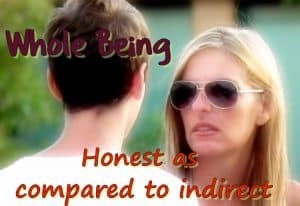
Whole Being — Honest as compared to indirect — we think that hedging or being polite is politically correct. What we end up with is a dishonest life.

Psst! Hey!
** Want more great writing designed to help YOU to shift your behaviour?
** Want to learn how to find, build or deepen your principal relationship?
** Want to know more about Zen living and being?
Honest as compared to indirect
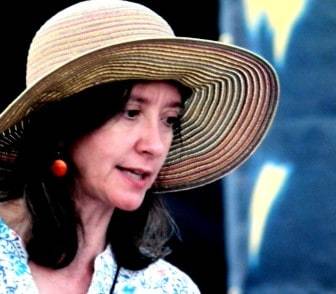
Here’s what I really think
Here’s a client story from back a ways:
I had a client with fibromyalgia; her physician referred her. He thought I might be able to help her to choose to feel better, as all the the medical interventions he’d tried — drugs and pain relieving salves and sleeping pills — weren’t doing much.
When she first came in, she let me know quite clearly that she wasn’t sure I could do anything for her; she wasn’t even sure why she was there. I agreed that I didn’t know why she was there either. I also agreed that there was absolutely nothing that I could do for her.
I wondered if she’d be interested in learning to do something for herself. Her interest piqued, and she decided to stay and try a session.
We had a long talk about illness. I said that I thought that most illness was psychosomatic in origin. Now, psychosomatic simply means, “having bodily symptoms of mental or emotional origin.” It doesn’t mean “imaginary,” nor is it a “mental illness.”
I was not laying “blame” — not blaming her for giving herself fibromyalgia. It’s just that people are rigid thinkers.
We get it in our heads that since our parents were a certain way, we have to be the same. \
Or, we’re told we are frail, or prone to something, and we develop it.
Or, we don’t listen to the voice of our bodies, so our bodies have no other choice than to speak louder.
Zen guy that I am, I figure that first we “simply notice”, and then shift behaviours.
Toward the end of the first session my client told me she was about to fire me — because she really didn’t like the idea that she gave herself fibromyalgia. Again, that’s not what “psychosomatic” implies, nor was it what I said.
I explained that I thought she was ignoring her body — not dealing with her feelings and emotions — because she was too busy looking after everyone else.
So, her body decided to get her attention.
Think about it — fibromyalgia is a disease whose only symptom is pain — one’s body screams, “Pay attention to me!”
She couldn’t imagine that this was what was going on. So, because what I said flew in the face of her belief system, I had to go.
Except that, prior to her actually firing me, I said something about self-focus and self-responsibility that she “got,” so she decided that I’d earned a reprieve.
I was pleased with her honesty, (about her process, her intention to fire me, everything…) and told her so.
She really wanted to let me know where she was coming from — and that she didn’t “get” everything I was saying. She figured that, despite her illness getting worse instead of better, surely my suggestion that a dose of self-responsibility and self-centeredness (see this topic in two weeks) couldn’t make things better.
I said that this was precisely what I thought.
I also said, “Maybe, just because you’ve spent your life being “other-centred” as opposed to self centred, your body decided to yell, “pay attention to me!” and did so through the voice of fibromyalgia. Maybe you need to spend as much time working on yourself as you do sticking your nose into what everyone else is doing!”
Now, I could have focused on politically correct language — congratulated her on her insight and agreed that I’d overstated my case. Or, I could have apologized for saying something she didn’t want to hear.
Either of these approaches is indirect or deceitful. Instead, I went for honesty.
I wanted to clearly state my perspective — here is where I stand and here is what I believe is going on.
To be perfectly blunt, when people have issues, I am never curious about how they set up their lives — or what they believe — because their belief systems contribute to their medical and emotional distress.
If I chosen to listen to my client’s beliefs, all she would have been able to do was explain to me how to end up with fibromyalgia. I was not interested in learning how to do that.
Nor am I interested in others teaching me about how to be “other-centred.” I focus on the person in front of me. I teach self-responsibility — what the person in front of me can do, how they might live their lives differently.
I focus on helping others find ways that will be substantially different from what they’ve been doing. I don’t want to pussy foot around and be subtle.
I want to state what I see, and explain what I see as the problem with their approach.
The direct approach, while blunt, is never cruel.
I learned this approach from Gloria Taylor, who was my therapist and supervisor. Two illustrations.
1) I was whining about how hard my life was and how things were not working out. Gloria said, “I just got a book that explains how to sort out this kind of stuff. All you have to do is read it and follow the author’s suggestions, and you will be fine.” She then handed me Living Life in Growing Orbits — my own book. That was an amazingly direct piece of therapy.
2) I was complaining about something or another that I’d ever again gotten myself stuck in. Gloria would shake her head and say, “Cute, but stupid.”
This is honesty in the extreme. I don’t want people to candy coat the truth.
Now, let me say quickly, before some of you, (and you know who you are!) decide this is license to be jerks about this — that honesty is not the same as being a know-it-all smart-ass. It’s not about how to speak the truth so you’ll be considered the most sarcastic person in the room. Nor is this about being guru-like.
Honesty is simply speaking the truth directly, as opposed to being cute, evasive or obscure.
Oh, and you only speak honestly to people who will listen. Others, who aren’t interested in your truth, can be ignored or fired. Plain and simple.
So, isn’t it arrogant to think I might know “the truth?”
I think not. Experience tells me a lot, and intuition tells me the rest. And in the end, I’m directly and clearly stating that I am only stating “my” truth. This is the world, as I see it.
Like The Pathless Path. This is my forum. This is a short course in “welcome to Wayne’s world.” If what I say doesn’t ring true for you, fire me. On the other hand, if you want to dialogue, drop me a line.
All too often, we make the choice not to speak the truth, as we think the consequences of not saying what needs to be said are better than the ones that will arise if we are honest. We end up feeling miserable as we stuff what needs to be said. Then, we get to feel like a martyr, which seems somehow noble. Much like whacking oneself repeatedly with a ball-peen hammer is noble.
Thank you, but no. Honesty and integrity go hand in hand. I need to have internal consistency if I am ever going to live a balanced life.
I need to be willing to see and hear anything without judgement, but at the same time be willing to speak honestly about what I see. I speak from the perspective of whether “whatever it is” works, not whether “it” is right or wrong.
If it doesn’t work, the only solution is to change it. That takes both honesty and courage.
This week, think about what needs to be said, both to yourself and to your nearest and dearest. Then, start with yourself, and call a spade a spade. You’ll be ahead, in the end, by always opting for honesty.
The post Whole Being — Honest as compared to indirect appeared first on The Pathless Path.
August 20, 2018
The Myth of Limitations
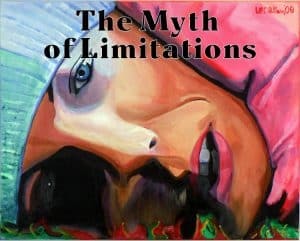
The Myth of Limitations – outside of physical limitation (which are mutable)the vast majority of limitations are self imposed. So, ask yourself why that’s a good plan!

Psst! Hey!
** Want more great writing designed to help YOU to shift your behaviour?
** Want to learn how to find, build or deepen your principal relationship?
** Want to know more about Zen living and being?
Our topic continues.
What follows is taken from a new book I’m working on. We’ll look at some beliefs that we could well do without over the next few weeks. This is a bit of the introductory stuff.
A myth is defined as “a theme or character type embodying an idea.” In other words, a story that conveniently explains how some aspect of the world works. For example, virtually all cultures have a creation myth, and a myth about how people came to be. And even myths about how people are blessed by God or the gods, and have dominion over the earth. We have created political myths, hero myths, myths about wealth creation (typically called “economic theories,”) and assuredly scientific myths. Those of you born in the early 50’s will remember being taught, in grade school, the solar system model for the atom. Big nucleus, little electrons circling in orbits. Then, in High School, we got to learn how many electrons could occupy each orbit.
Now, we know that there are no such things as orbits, that sub atomic particles make up the atom, that they are actually waves, that we cannot know both their speed and their location, making them sort of not there, and then, we find out that atoms are 99.9999999 per cent nothing. At least, that’s this decade’s myth. We seem to need someone in authority to tell us what is real, as opposed to understanding that nothing and everything is real. When asked what is real, a good, truthful scientist (the shamans of our age) will say, “That depends.”
The Myth of Limitations
Much like the rest of the myths, limitations are self-imposed… and usually for no good reason. Now, I’m not talking about jumping off a ten story building and thinking I’m going to land safely. I’m talking about what we tell ourselves about our relationships, our skills and talents, our bodies and our minds.
It’s so weird… we’re often criticized if we don’t lead with our limitations
Canadian culture for sure equates being positive about strengths and abilities as bragging, or being too wrapped up in ourselves. I suspect this is something that happens world-wide.
Many get nervous or judge-y around successful people — like success is in limited quantities, and another’s success could mean less for me.
Others limit themselves so that others lower expectations around them. After all, if we admit to how much talent and ability we have, someone might expect us to follow through. So we shy away.
Years ago, as a kid, I learned from a very wise person that I should determine for myself who I was and who I wanted to be.
If I sat around listening to people tell me who to be and what to do, at best I’d be running from one thing to the next, trying to be everything to everyone. I learned that lesson well.
I’ve also learned that not everyone likes me, my opinion, talents, drive.
I’d rather deal with the consequences of not being liked by everyone than to live my life as they do; pushed in, repressed, drugged, drunk, and numb. I accept that as the price I pay.
Limitations are artificial constructs. By believing in them, you get to whine along with others about how hard done by you are. Hey! Gather up enough whiners, and you can even elect Doug Ford or Trump. I guess it’s true: misery really does love company.
To believe that we are free; that we can create, achieve, and really make a difference — this is the mark of wholeness — and of life truly lived.
I would suggest that you take a moment from your reading, and note down anything that has occurred to you regarding your own limiting behaviours. Have I touched any nerves in the last few articles? What myths do you believe in?
Strange Behaviours to Notice
We are very close to talking about solutions — but first, I like to frame what doesn’t work — it’s the way my mind works, you see.
 I’m bored being bored
I’m bored being boredHere are several behaviours that many engage in and which lead precisely nowhere:
Blaming —
Scott Peck, in The Road Less Traveled, differentiated between neurosis and psychosis this way: — neurotics blame themselves, and psychotics blame everyone else. He wrote that he’d rather work with a room full of neurotics than one psychotic. Why?
The neurotic is right! The stuff we have to deal with is our responsibility. We’re not to blame, but we are responsible.
Until we’ve done the same dumb thing over and over. Then, I am not above asking how many times a person has to bash into the wall before noticing it’s there.
Blaming others is a linchpin in our society. If you still listen to the news, you will daily be bombarded with the “blame flavour” of the month. Used to be the Russians. Then Iran. Of course, all the jobs are going to immigrants. On and on.
Grown up kids blame their parents for everything. “It’s not my fault. I can’t do anything about it,” is the prevalent theme.
We hear it so much that it actually sinks in. When something goes wrong, rather than turning inside and wondering how we set life up to go the way it is going, we look around for someone to point a finger at.
The problem with this, of course, is that it means that nothing will change. It won’t change because the person doing the blaming is looking for a solution outside of him or herself.
Inertia —
Inertia is choosing to stay stuck. It happens when we decide there is nothing we can do about our lives, our problems, and the world. It is a cousin to giving up (see below), but not quite so passive — you go through the motions, but never do things differently.
Reminds me of a skit. Bunch of people are sleeping on the floor. There is a loud howling from off stage. The person farthest away nudges the person next to them, and says, “Zeke, see what that noise is. I’m too tired to move.” Zeke turns to Kate and repeats the line. It moves across the whole group. Finally, the last guy gets nudged. He sees there’s no one else to nudge, so he slowly gets up and walks over to the window. He looks out, walks back, lies down. Finally, he turns to the person who nudged him, and says, “It’s just Uncle Jed, sitting on a cactus plant, and he’s too tired to move.”
Cocooning is the modern equivalent of inertia. You build your home into a fortress designed to protect you from the outside world. You take up knitting. *
August 13, 2018
The Myth of the Threat of Change
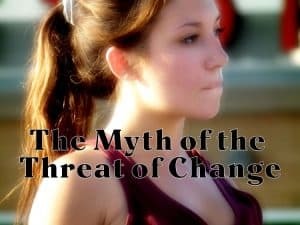
The Myth of the Threat of Change — many people fear change, so they stay stuck. Yet the fear is almost always baseless.

Psst! Hey!
** Want more great writing designed to help YOU to shift your behaviour?
** Want to learn how to find, build or deepen your principal relationship?
** Want to know more about Zen living and being?
Our topic continues.
What follows is taken from a new book I’m working on. We’ll look at some beliefs that we could well do without over the next few weeks. This is a bit of the introductory stuff.
A myth is defined as “a theme or character type embodying an idea.” In other words, a myth is a story that explains how some aspect of the world works.
For example, virtually all cultures have a “creation of the world” myth, and a myth about how people came to be — about how people are blessed by God or the gods, and have dominion over the earth.
We have also created political myths, hero myths, myths about wealth creation (typically called “economic theories,”) and even scientific myths.
Those of you born in the early 50’s will remember being taught, in grade school, the solar system model of the atom. Big nucleus, little electrons circling in orbits around the nucleus. Then, in High School, we learned how many electrons could occupy each orbit.
Now, we know that there are no such things as orbits, that sub-atomic particles make up the atom, that they are actually waves, that we cannot know both their speed and their location (making them sort of not there,) and then, we find out that atoms are 99.9999999 per cent nothing.
At least, that’s the current myth.
We seem to need someone in authority to tell us what is real, as opposed to understanding that both nothing and everything is real.
Which means that when asked what is real , a good, truthful scientist (the shamans of our age) will say, “That depends.”
The Myth of the Threat of Change

Laughing in the face of change
John Savage, a trainer in conflict resolution, describes various “neuro-sorting” techniques to help us see how our minds are set up. Research backs up the percentages below. (i.e. it’s not fake news…
August 6, 2018
The Myth of Easy
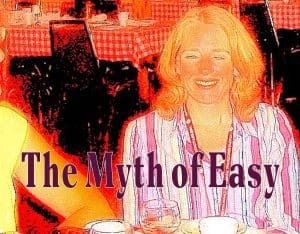
The Myth of Easy — We have funny beliefs, and one of them is that we “ought to be” comfortable, and life ought to be easy. This tends to mean that we think others ought to move heaven and earth so that we are. Not so!

Psst! Hey!
** Want more great writing designed to help YOU to shift your behaviour?
** Want to learn how to find, build or deepen your principal relationship?
** Want to know more about Zen living and being?
Last week’s article about myths has certainly touched some of you, and I’m choosing to continue with this topic.
Here’s a bit of the introductory stuff I mentioned last week.
A myth is defined as “a theme or character type embodying an idea.” In other words, a myth is a story that explains how some aspect of the world works.
For example, virtually all cultures have a “creation of the world” myth, and a myth about how people came to be — about how people are blessed by God or the gods, and have dominion over the earth.
We have also created political myths, hero myths, myths about wealth creation (typically called “economic theories,”) and even scientific myths.
Those of you born in the early 50’s will remember being taught, in grade school, the solar system model of the atom. Big nucleus, little electrons circling in orbits around the nucleus. Then, in High School, we learned how many electrons could occupy each orbit.
Now, we know that there are no such things as orbits, that sub-atomic particles make up the atom, that they are actually waves, that we cannot know both their speed and their location (making them sort of not there,) and then, we find out that atoms are 99.9999999 per cent nothing.
At least, that’s the current myth.
We seem to need someone in authority to tell us what is real, as opposed to understanding that both nothing and everything is real.
Which means that when asked what is real , a good, truthful scientist (the shamans of our age) will say, “That depends.”
The Myth of Easy
We only have to go back to the Depression and the generation after — up to and including World War II — to find the opposite of the Myth of Easy. People prior to the end of WWII would, in general, tell you quite clearly that
life is hard,
there will be struggles,
and that simple survival was what life was all about.
When tragedy struck, families rallied, and life went on.
Today, the Myth of Easy says that:
nothing should be painful.
There should be no lessons, other than easy ones.
School should not make demands.
Work should not expect excellence.
Others (people we are in relationship with) should put us first.
For example:
God forbid we give little Suzie the grade she deserves, or hold her back because she blew 9th grade.
Never mind that she was popping pills and drinking.
Never mind that she was hanging around with a group of losers.
Never mind that when something went wrong, little Susie always blamed others: her failure was the fault of the teachers, the school system.
No, pass her. Lest her precious little ego be damaged.
And then it’s 5 years later, and a professor at University or a boss makes a demand for work, and little Susie flips. “No one told me it was like this!”
We of the 50s and later grew up under the Myth of Easy, Security and Having it Better than Dad.
Remember annual raises? We got them because that’s what happened each year, not because of performance. Raises were our right, remember? And people whine because now raises might be tied to performance or some actual standard imposed by one’s boss.
Personal growth was the buzzword of the 60’s. It, too, was to be easy and quick. One est weekend here, one colonic there, a chant and a mantra… and everything would be better.
If anyone suggested that enlightenment comes in fits and starts, after much effort and with painful, continued difficulties, the Cult of Easy said, “If I give you more money, can you speed up the process?”
So, now, in this era of Trump and the 1%, many are cocooned in their Lazy Boys, hoping that the pain will stop. They declare, “It wasn’t supposed to be this way.” And then they go out and yell at people they deem to be “illegals.”
Well, baloney. As Scott Peck reminded us in The Road Less Traveled, “life is difficult.” Learning, changing, healing, all come at a price. No learning happens without pain. The pain may be nothing more than the pain of having to give something — some behaviour — up, or it may be a “shaken to the foundations” type of pain, but it is a necessary component of growth.
The Cult of Easy has nothing to do with wholeness. It has to do with hard, hard work.
Of course, we all wish it were different, and all that wishing means that most people are stuck in one of the following “easy — comfort” loops.
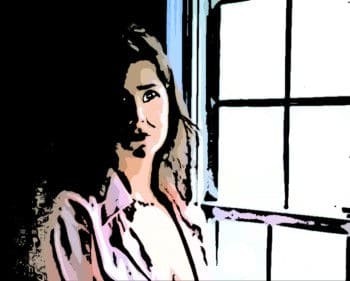 Waddaya mean I have to work on myself?
Waddaya mean I have to work on myself?Content vs. Right
Many folk want to be declared right. They want others to agree with their point of view. They see their mission as changing others. This is a comfortable place, as it never involves self-reflection. It simply involves judging others and finding them lacking.
This is otherwise known as the blame game.
A minister once had a man in his congregation who was absolutely messed up. His behaviour was atrocious. Finally, the minister decided to preach about this man. She started off subtly, making allusions to the aberrant behaviour. Each week the man would walk up to the minister, shake her hand, and say, “That’s telling them, preacher!”
This went on week after week.
Finally, there was a snowstorm, and the only two people in church were the minister and this man. She decided to go for broke. She preached right at the man. Spelled it all out. End of the service, she’s at the door. The man walks up, looking real sad, Grasps the minister’s hand. Says, “That’s telling them, preacher. If only they’d been here!”
contentment is inversely proportional to judging. The more you judge others and try to change others, the less content you are. The wise person learns that the first and greatest discipline is to focus on simply observing others, rather than trying to change them.
Manipulating others into changing
This one is a second cousin to the first. It goes, “If others would change, then I could be happy.” It’s different from the first in this way. The person does not tell the other person how to act from a position of superiority. The person wants others to change from a position of “one down.”
“If only you would see the pain you are causing in me. If you really loved me, you would change.”
People think this way because we want others to do all the work. That way, we can keep doing all sorts of silly stuff, and the other person lets us.
I had a couple for clients. He worked evenings, she worked days, and they had a one year old. She expected three things of him:
That he do the laundry, every day.
That he vacuum the rugs, every day.
That he polish the kitchen taps and sink, after every use.
She declared that these were the rules she’d learned, and if he loved her, he’d do these things for her. Of course, there were always other items on the list; items that changed. And he was expected to watch their son.
I worked with her for some weeks, trying to help her to see that perhaps such rules were not graven in stone. She refused to budge. Finally, the husband agreed to do the three things, plus the rest of his tasks. He figured it was better than fighting.
What turned out to be our last session happened like this: He walked in. He was sick. Had been, all week. He announced that he had been too sick on Monday to do his jobs, but she’d forgiven him. He’d crawled out of bed on Tuesday, and done everything. Today, Wednesday, he’d managed to vacuum and do the laundry.
She walked in, glared at both of us, said; “I went home ahead of our session. You willfully neglected the taps and sink. The marriage is over.” And so it was.
We want to blame others for our distress. It is easy to blame, harder to take responsibility for the things that are happening in our lives. Because of the Cult of Easy, we think others should have our best interest in mind. It is quite a shock to discover they don’t. Many people “solve” this problem by changing people. The brave few simply recognize that wholeness is not about getting others to behave themselves.
“I’m No Good!”
Another variant. I had a client who would burst into tears and say, “It’s all my fault. I’m not a good person. I’m to blame.” This is not as bad as it seems, as at least she was using the right pronoun. It is, however, a comfort-zone technique.
Feeling bad about oneself gets to be a habit, just like everything else. It requires no effort, because people who use such lines seldom conclude with — “and so here is what I am going to do differently.”
This technique allows you to sit back, tell yourself off, feel bad, sulk, maybe get some attention from those around you, and not have to change a thing.
As opposed to the truth of wholeness. “You are responsible for your life, and only you can change the way you see life, respond to others and treat your self.” You are “response able” — able to respond.
More next week!
The post The Myth of Easy appeared first on The Pathless Path.
July 30, 2018
Life is not as it is. Life is as you are.
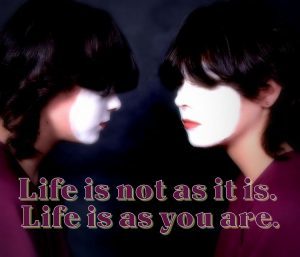
Life is not as it is. Life is as you are. — reality is slippery and personal. This scares a lot of people, who crave fitting in.

Psst! Hey!
** Want more great writing designed to help YOU to shift your behaviour?
** Want to learn how to find, build or deepen your principal relationship?
** Want to know more about Zen living and being?
Here’s a “Life is as you are” quote from the old TV show, “Third Rock from the Sun.”
Mary: “Dick, you are just going to have to accept that there are some things in life you are not going to understand.”
Dick: “Oh, I accept it — BUT WHAT ARE THEY, AND WHY DON’T I UNDERSTAND THEM?”
Here on The Pathless Path, we haven’t got much use for “understanding” what is “true.” Most of the time, seeking truth and understanding is a useless pastime. Please note! I’m referring to inter and intrapersonal understanding, not, for example, the rules of the road. Because we all need to stop at stop signs and drive on the side of the road appropriate to where we live.
At the interpersonal level, there’s this: many years ago I was doing some business consulting, and someone warned me: “Well, asking questions in a meeting probably doesn’t fit within the protocols of our company.” The explanation was that the president thought he was really smart (not quite a stable genius, but…
July 23, 2018
It’s Not Always So
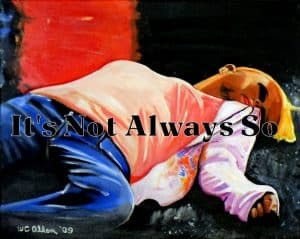
It’s Not Always So — Things are as they are, not as we imagine them to be. Learning this lesson means accepting ‘The way it is, is the way it is.’

Psst! Hey!
** Want more great writing designed to help YOU to shift your behaviour?
** Want to learn how to find, build or deepen your principal relationship?
** Want to know more about Zen living and being?
Today’s subject is taken from the title of a book by the Zen master Suzuki Roshi — he said that the simplest definition of Buddhism (and, I would argue, life) is “It’s not always so.”
All descriptions of reality are limited expressions of the world of emptiness. Yet we attach to the descriptions and think they are reality. That is a mistake.
Not Always So: Practicing the True Spirit of Zen, pg 33
Most people believe that if you study hard and work hard, you’ll be successful.
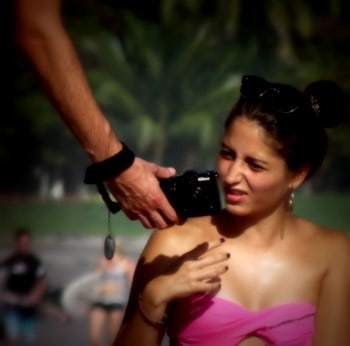 I couldn’t possibly look like that
I couldn’t possibly look like thatWell, studying hard and working hard might make you smart and rich. Neither will (necessarily) make you wise, nor successful. Unless you’re looking for the kind of success that is measured in letters after you name, titles on your office door and mega-bucks in your bank account.
None of which is a “bad” thing. It’s just a sadness when it’s the only thing.
Most of us hold a deep belief that things should be explainable and logical, and that consequences should always and reliably follow events.
Because we live in a physical world that seems to follow rules, we make the leap that our personal life should actually imitate science, not art. We figure that if we endlessly scrutinize and dissect our past, our relationships, and our processes, we will eventually figure out “the way it is” — once and for all time.
We desperately hope to discover that the world is “just so.”
This desire for just so-ness is a desire not for truth but for uniformity — an, “Everyone knows that this is the way it is.” There is this deep yearning to find the right teacher, guru, therapist, religious leader — the one who can clear it all up, for all time.
Underlying this is the expectation that when I fully understand, life will be easy, and the path will be clear.
This would explain how, so very often, we get into battles with those we love, and often those battles are nothing more than attempts to have our world-view validated, and then followed, by the other person.
We’ve put so much effort into being right — to figuring it all out — so we refuse to let go of all of our work.
We fear that “nothingness” — that negation will be the result of dropping our self-understandings and self-definitions.
Even though they are illusions. Because… It’s Not Always So
The way out of this particular drama is to surrender our desire for permanence — surrender our belief that something, anything, is right for all time.
What, then, would my life be like if I strove to be at peace, living within my own skin, feeling contentment while being present? My guess is that, in order to achieve this way of being, I would have to accept Suzuki’s point — it’s not always so. Or, to quote Stewart Wilde, “The way it is, is the way it is.” Right now.
Here’s a quote for you:
Consciousness cannot be confined to egocentric self-concepts. Existential reality is practical in terms of coping with the ordinary tasks of living in the world, just as Newtonian physics is practical for building bridges. However, exclusive identification with the existential self as an independent entity makes no sense in view of states of consciousness that transcend ordinary space/time limitations and operate in a reality that is more aptly described in the language of sub-atomic particles.
Frances Vaughan, The Inward Arc
As you grasp this wisdom, you realize that the most disturbing aspect of being human is the stark realization of the relative unpredictability of life.
Coupled with that is the realization that we are, beneath the veneer of socialization that allows us to interact, totally different beings. We see things differently, interpret things differently, react or resist differently. We literally live in our own universe, made up of constructs and definitions that are, in the main, unique to ourselves.
There is almost a desperation out there, as people run from pillar to post trying to discover the meaning of life, or even glimpse the meaning of their life. Rather than simply accepting the reality of themselves in this moment, they seek solidity and assurances that they are “OK.”
There is something extremely valuable in simply showing up for whatever is going on.
Yet, fear often keeps us from truly showing up. Fear, however, is based upon a thought projected forward; it exists only out of the moment, in the realm of “what could happen.”
Well, what could happen is not what is happening.
What is happening may run the range from pleasurable to painful, and of course, because it is what is happening, you have to actually deal with it. Fear based fantasies simply cause us to pretend we can hide from the moment.
One of the things I notice as I practice being mindfully present — and as I am able to let go of the need to define my process (if we are busy defining the process, we are not experiencing the process — we are in our heads, playing with words again… and again) I find that stuff just slides through without “sticking.”
Now, I suppose that people who don’t like living in the moment — in uncertainty, in the state of non-definition — would judge that their continual self-chatter and self-definitions enrich the moment. I would disagree.
It seems to me that to define is to go non-present, and in non-presence I cease to have the actual experience, as I am to busy having my interpreted experience. And often, I have per-determined what that experience is going to be, based upon faulty memories of past experiences that I judge, in my desperate need to have by life be “just so.”
I judge that my interpretations are true, as opposed to convenient figments of my present imagination.
Thus, if I am pre-disposed to fighting with my partner, I am pre-disposed to having the fight regardless of what is actually happening in the moment.
If I am pre-disposed to having sexual encounters, everyone and every situation is sexually charged.
If I am pre-disposed to being sick, or being shortchanged by store clerks — to being hard-done-by — I will have these experiences in spades – almost drawing them to myself — and will ignore any evidence to the contrary.
I will believe what I believe, no matter what is actually going on in the present moment.
How to let this go? I would strongly suggest that “simple presence” is more than enough.
In the end, the only thing that matters is how content I am with the choices I am making.
Nothing is “so” and certainly nothing is “so” forever. Not inside of us, at our depths.
Physical reality seems to be “so,” — i.e. I’m going to die. But since I can’t know “when,” it’s still a crap shoot.
Maybe the goal of incarnation is to learn to ride the wave of life gently, with flexibility. Gently.
Or not.
It is how you see it — right now.
The post It’s Not Always So appeared first on The Pathless Path.
July 16, 2018
Enlightened Choice
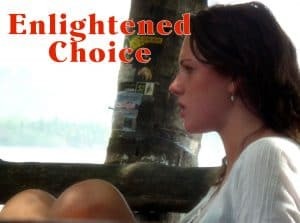
Enlightened Choice — there is no real state of enlightenment. All there is, is moment by moment choice.

Psst! Hey!
** Want more great writing designed to help YOU to shift your behaviour?
** Want to learn how to find, build or deepen your principal relationship?
** Want to know more about Zen living and being?
I’ve been to re-reading what I wrote back in 1999. As I actually enjoy reading what I write
July 9, 2018
Learning to Love Little Things
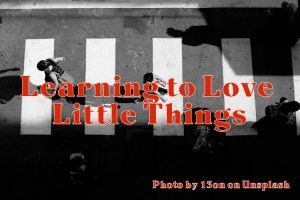
Learning to Love Little Things — we get so focused on the big externals (drama!) that we lose sight of the only thing that matter — what’s going on inside — the little things.
A couple of Rumi quotes:
When you eventually see through the veils to how things really are,
you will keep saying again and again,
“This is certainly not like we thought it was!”
Be patient. Respond to every call that excites your spirit.
Ignore those that make you fearful and sad, that degrade you back toward disease and death.
No need to announce the future!
This now is it. This.
Your deepest need and desire is satisfied by the moment’s energy
here in your hand.
And, in speaking about “god,” Rumi wrote:
In your light I learn how to love. In your beauty, how to make poems. You dance inside my chest, where no one sees you, but sometimes I do, and that becomes this art.
Quoted from: The Essential Rumi, trans. by Coleman Barks
In my own life walk, I notice how easy it is to distract myself with “large things,” which inevitably are “out there.” I suspect that I mostly bog myself down by not going “in” enough — not noticing the “little things.”
It is a complicated and ultimately fruitless walk to wander here and there, seeking yet one more affirmation, one more book, one more quote, one more technique. There are all external things — all of which says the same thing and none of which becomes our core way of being.
Instead, we need to continually look at who are who we are at the core of ourselves . The work and the walk, the truly Zen approach is, as it has been said, “an inside job.”
And not a particularly complicated one, at that.
Oh, I know. We want to make it both complicated and large. Here’s an example:
A client described problems with her parents, her ex-husband, creditors and her kids. After each description she would sigh and say, “If only I didn’t have this needy (person, thing) in my life, I could be happy. I’ve spent years trying to fix things. But they never change.”
The “stage” of her life seemed to be the size an amphitheatre… and the drama the size of Everest… until you look inside.
Inside, you would see this person standing bowed over under the weight of her life, choosing to try to make things all better for everyone else.
As we explored this, she could not think of one time that her efforts at bailing out another had ever worked. Not once! She stated that, in middle age, life had passed her by, and that she’ll never be happy. Besides, her kids are 13 and 15, she’s separated, and all of her time “should be” dedicated to keeping them happy. Right?
I demurred.
Her issue, you see, what not the “difficult others” in her life. Her issue was that “outside” was the only place she was looking.
For Rumi, the “way” of life — for Zen, the “way” of life, might be described as looking deeply into a mirror. Rumi says, “The green felt cover slips, and we get a flash of the mirror underneath.”
Even when the external times are difficult.
I mentioned some weeks ago how a friend of our down here seems to be immersed in all things Trump. Dar and I drove him the the airport yesterday. We got to within 15 minutes of the airport before he tossed out a soft pitch.
He said that I’d been right about something immigration related. My little ego perked right up. Then, he rounded on me, I bit, and we were once again away to the races.
Dar refused to bite. My supervisor used to call her The Buddha. She’s right.
I finally stopped myself, dropped him off, had a breath, and went back to being present — i.e. Trump isn’t here in Costa Rica. It was all sun, blue sky and white clouds. I found myself flowing within myself, seeing images, hearing the voices of friends old and new, here and there, living and dead. I felt truly alive, in the moment, and lacking nothing.
This morning my shoulders are tight, and I have a headache. A reminder from my body that playing with externals is never a good idea; there is only what I can do, now.
 Choosing to be head over heels
Choosing to be head over heelsThere are such depths of riches within each of us, and much of it is pushed aside on the altar of wishing life was other than it is. So much external data, flooding by, and such a temptation to assign importance to any of it. So many people, so little time.
This is not about retreating from reality. This is not about refusing to actually do something to change the world.
It’s about actually doing something, as opposed to only complaining… and then expecting that to accomplish something.
You have to stop yourself.
Then, your eyes open to the simple pleasure of sitting in silence, breathing.
It’s living primarily in the internal world, and then making what we learn about ourselves manifest in the external world.
Where is your passion? Where else? Inside, waiting for you to show up and notice. Where is your vocation? Where else? Inside, waiting for you to take it seriously. Where is your voice? Inside, bubbling over with your words, understandings, all waiting to be expressed. Where are your relationships? With whom? There’s only you, loving you. Or not.
All there is — all — is now. It’s all — now. When you get this, you resonate with Rumi: “This is certainly not like we thought it was!”
Amen to that!
The post Learning to Love Little Things appeared first on The Pathless Path.
July 2, 2018
Equanimity
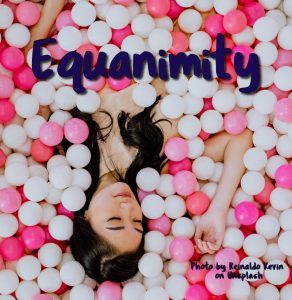
Equanimity — we all have issues dealing with our ‘pet’ emotions — mostly, we want them gone. Not possible. Equanimity in the face of them — possible!

Psst! Hey!
** Want more great writing designed to help YOU to shift your behaviour?
** Want to learn how to find, build or deepen your principal relationship?
** Want to know more about Zen living and being?
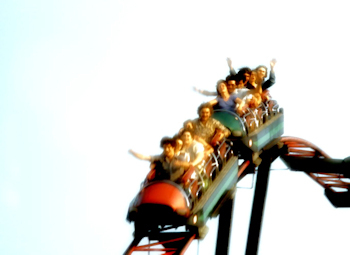
I’ve been pretty good at dealing with my emotions… but!
Many moons ago I decided to get over being the “angry little man,” as one of my supervisors called me. With a lot of effort, I learned not to respond to anger with anger.
The weird (yet obvious) piece is that I still feel anger, despite years of meditation practice.
It’s weird because I know better than to think that any of my emotions are gone.
Let’s begin by looking at equanimity. I borrowed the term’s usage from a book called “The Science of Enlightenment”, by Shinzen Young,
Young writes that equanimity is the art of having our thoughts and feelings — the art of feeling them fully, expressing them, and then simply letting them go, without judgement.
I think we get it into our heads that we’re supposed to be “getting past” our feelings, emotions — past the stuff that we judge to be “baser” or beneath us (enlightened beings that we think we are.) We get our shorts twisted into a knot, then we work hard to stuff the feeling, and then we get all over ourselves for feeling it in the first place.
Sound familiar?
Young recommends releasing what we feel.
He mentions Zen masters — that they’re quite the “out there.” They laugh, cry, get angry, shout. Young thinks their “expressing” of emotions is an authentic meditative practice — because it is an accurate reflection of what the master is feeling at that moment.
He describes this expressing as a letting out — it is not directed at others in a hurtful way. Afterward, there is no recrimination, self-doubt, or self-hatred.
Here’s a quote along a similar vein:
Working with AngerOne reason anger is so powerful is that it is a mechanism of survival. We need it. But how do we work with it so it doesn’t become a weapon of destruction?
First of all, we have to believe that anger can be purified of its toxic content and channeled in wholesome and creative ways. Anger provides information. We know that physical pain should not be ignored; it is informing us of a problem that needs our attention. Likewise, anger informs you that your mind and heart are in pain. So anger is not a problem—it is a messenger. (page 23)
Excerpted from:
Zen in the Age of Anxiety: Wisdom for Navigating Our Modern Lives
by Tim Burkett
This is a tough one, simply because our nature, when angry, is to want to blame and then hurt someone else.
Or, at least, we want to shift the focus to the behaviour of the other person. And, we likely will beat up on ourselves in the process.
It’s all too easy to find ourselves deeply buried in whatever our emotional process is — and unable or unwilling to see what’s going on. After I decided to be less verbally angry, I found myself blocking and burying the anger. Except, and here’s both the joke and the Bodywork part, blocked and buried does not equal gone.
I have a Bodyworker friend here in Samara; he was doing his thing today, and I was noticing that right beneath my tightness were tears. They were there in general because of the state of the world, but specifically because I was thinking, ever again, that I was unseen and under-appreciated.
I mentioned that, for the first time ever, I was grinding my teeth a bit.
My buddy popped on a finger dam, and massaged the muscle of my jaw. Sweet baby Jeebuz that hurt. Being a good former Bodyworker, I moaned, and let him do his thing (i.e. I didn’t bite off his finger.
June 18, 2018
Everything is Phenomenal
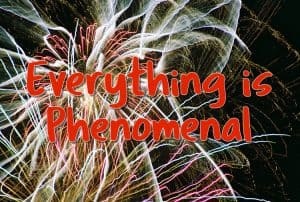
Everything is Phenomenal — it’s a moment-by-moment experiencing, not a fixed thing. You can’t get a handle on it — but you can begin to notice, let go, and return to your essence.

Psst! Hey!
** Want more great writing designed to help YOU to shift your behaviour?
** Want to learn how to find, build or deepen your principal relationship?
** Want to know more about Zen living and being?
 It all flows by… like water.
It all flows by… like water.One of our friends here in Costa Rica likes to be provocative. He knows that I (seemingly) can’t resist a good old Trump conversation, and he’s well-versed at probing.
Darbella and I were heading to a play rehearsal, and that’s when he started. I bit, and off he and I went, despite our need to leave. I got a bit wound up, but fortunately was also able to watch the interplay and dialogue between us.
I was thinking, “This is like a tennis match.” I recognize now that we were focused on phenomena.
Not so long ago, I was listening to some old Ram Dass lectures. RD suggested doing a Buddhist exercise designed to get you to the point of noticing your essence — your essential nature if you will.
(I’ve spelled out a lot of this in my free booklet, The Watcher ( download here) and even more in my book, Living Life in Growing Orbits.)
Ram Dass suggested a little exercise — one I call “Watching Your Filters.” Give it a try.
Begin by noticing what you are hearing. After a minute, focus in on really hearing all the sounds around you.
“Whoa! I sure wasn’t hearing that a moment ago!”
Correct. But imprecise.
If you think about it, the sounds you are now hearing were there — were vibrating your eardrums — prior to your noticing (paying attention to) them. So, ask yourself: “Who or what is it that chose to “not attend,” then “attend” to the previously unheard sound?
Buddhists would posit that we each have within us an observer, which might be thought of as our true essence. It is “that which hears,” or sees, or feels all of the sounds, sights and feelings.
Pure essence, pure observation.
This essence or awareness makes up everything in the universe, including us. So, in a sense, as Dar and our friend and I were having the Trump conversation, it was actually the same essence talking to itself.
To put that another way: the energy of the universe talks with itself by incarnating. Becoming humans is how “life” has a way — a vehicle — for interacting with itself.
The “field” in which this essence interacts, is everything else — the world, our jobs, careers, dramas, events… AND our bodies. All of this — this “everything else” — is phenomena. Stuff — meaningless stuff.
A client story: this guy had a son, and the son had the label schizophrenic (“Hi. I’m schizophrenic.” “Oh, hi. I’m Wayne!”) hung on him. The dad had spent the two weeks obsessing about how his son had spent his rent on CDs.
The dad described several bail-out manoeuvres he’d devised — thought up — to “help” his son beat getting evicted. And the dad had spent 2 weeks not talking with his wife, and she had spent two weeks watching the dad obsess.
The dad’s obsession was all in his head; his thoughts were not real. They were all phenomena.
The punch line: a few days later, the dad went to his son’s place, and the son had worked the whole thing out with his landlord. No drama, no eviction, just more phenomena.
We could argue that dad had wasted 2 weeks. We would be right. A more “essential” (as opposed to game-playing) response from dad would have been that he engage with an open heart and see what was actually happening.
All of his obsessing accomplished exactly nothing.
Or, as my favourite poet, Rumi, put it:
We seem to be sitting still, but we’re actually moving, and the fantasies of phenomena are sliding through us like ideas through curtains… We can’t know what the divine intelligence has in mind! Who am I, standing in the midst of this thought-traffic?
Ram Dass sees the work of incarnation as learning to “still the mind” — to be present while observing that thoughts “come and go.” If you attach yourself to any of them, you lose yourself.
Now, what might this mean?
If you attach to your body, then your interpretation of your body becomes “true” — and the only way you see your body. “I can’t do this” becomes your reality. Every pound, blemish, scar, your age, whatever, becomes the focus of your life.
If you attach to your relationships, then your interpretation of the mood of your partner, or a perceived slight, or an arched eyebrow, or a remark, becomes “true,” and the focus of your life.
If you attach to your job, then your interpretation of the direction of the work, the mood of your boss, the acceptance or rejection (seemingly) of your ideas becomes “true,” and the focus of your life.
If you bring your attention to the Watcher — to the essence — to the place where all that we are is “that which observes,” all of your attachments become what they really are — no-thing but ideas floating through you like poop through a goose.
Nothing is real, you see. It’s all phenomena. Nothing is anything other than how you choose to see it.
That text from Rumi comes from a long narrative piece about a frog and a mouse. The gist of the story is that the mouse stands for the body — dense (in more ways than one) needy, wanting contact with the frog, which is free-flowing essence (or what Rumi calls divine intelligence.)
The body is so needy that it decides that it must have a permanent bond between it and this essence.
Rumi describes the true nature of incarnation and essence. Let me quote a bit, as the mouse speaks:
Exerpted from The Frog and the Mouse
Rumi
Again, the mouse, “Friend, I’m made from the ground, and for the ground. You’re of the water.
I’m always standing on the bank calling to you.
Have mercy. I can’t follow you into the water.
Isn’t there some way we can be in touch?
A messenger? Some reminder?”
The two friends decided that the answer
was a long — a longing! — string, with one end tied
to the mouse’s foot and the other to the frog’s,
so that by pulling on it their secret connection
might be remembered and the two could meet,
as the soul does with the body.
The froglike soul often escapes from the body
and soars in the happy water. Then the mouse body
pulls on the string, and the soul thinks,
“Damn, I have to go back on that riverbank and talk
with that scatterbrained mouse!”
You’ll hear more about this
when you really wake up, on Resurrection Day!
So the mouse and the frog tied the string,
even though the frog had a hunch some tangling was to come.
If we choose to notice the phenomena that flit through our minds — and then just choose to let them flit through — if we choose to sit as a witness with our friends and watch as their attachments flit through — we then have a chance to let go of each of them in turn, and simply be.
For example, with Darbella — I don’t want to possess her, or direct her. I don’t want to bite on her dramas, nor do I want to bite on mine.
I want to see, truly see, what I am clinging to, and softly let it go. I want to tug on the string of my essence, and talk unceasingly with that which is truly “I”. I stand in awe that my essence comes when I tug on that weird string, despite my eseence knowing that the tugs come from “that scatterbrained Wayne!”
As I relate with my friends, I relate to myself. They are I and I am they. Their dramas are my dramas. I can spend my life fixating on the drama, feeling crappy, changing nothing, whining, complaining, or feeling helpless. Or, I can let go of my attachment to phenomena, bring myself into the present moment, and simply be — in my body… “in the world, but not of the world.”
I return, again and again, to myself. I offer myself a reminder about letting go. As to Darbella and my friends, I can choose to see their essence — and then, everything is as it is and as it should be.
My deepest desire is to be a witness, to them, to me, and a witness of life itself. And I can even let go of that desire — if I choose to.
The depth of enlightened action is to hold nothing while witnessing everything .
Because in the end, at the end, as my toes curl up and I breathe my last, it’s just me and my frog. And then, it’s just the frog. And then, it’s just…
The post Everything is Phenomenal appeared first on The Pathless Path.



